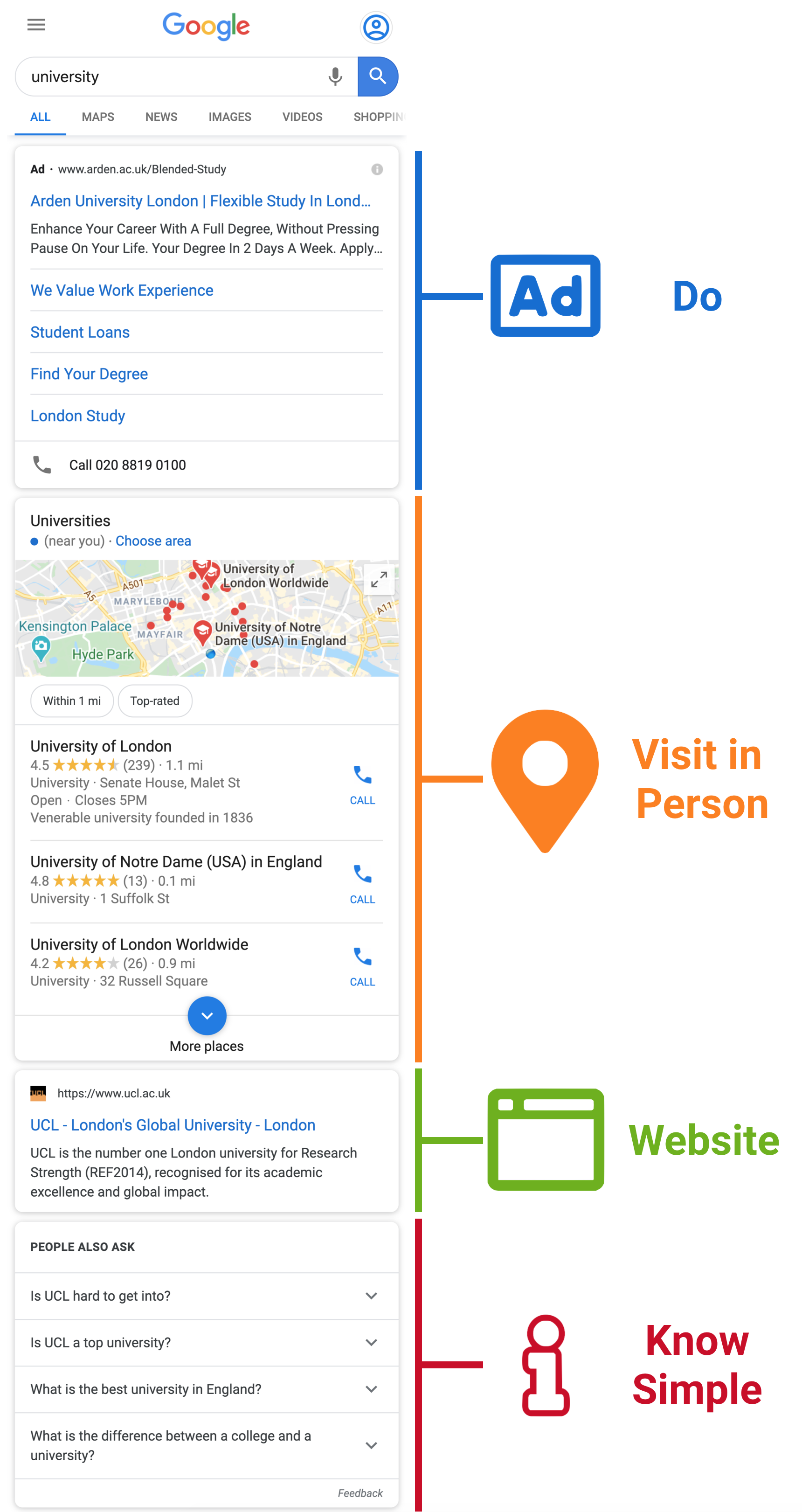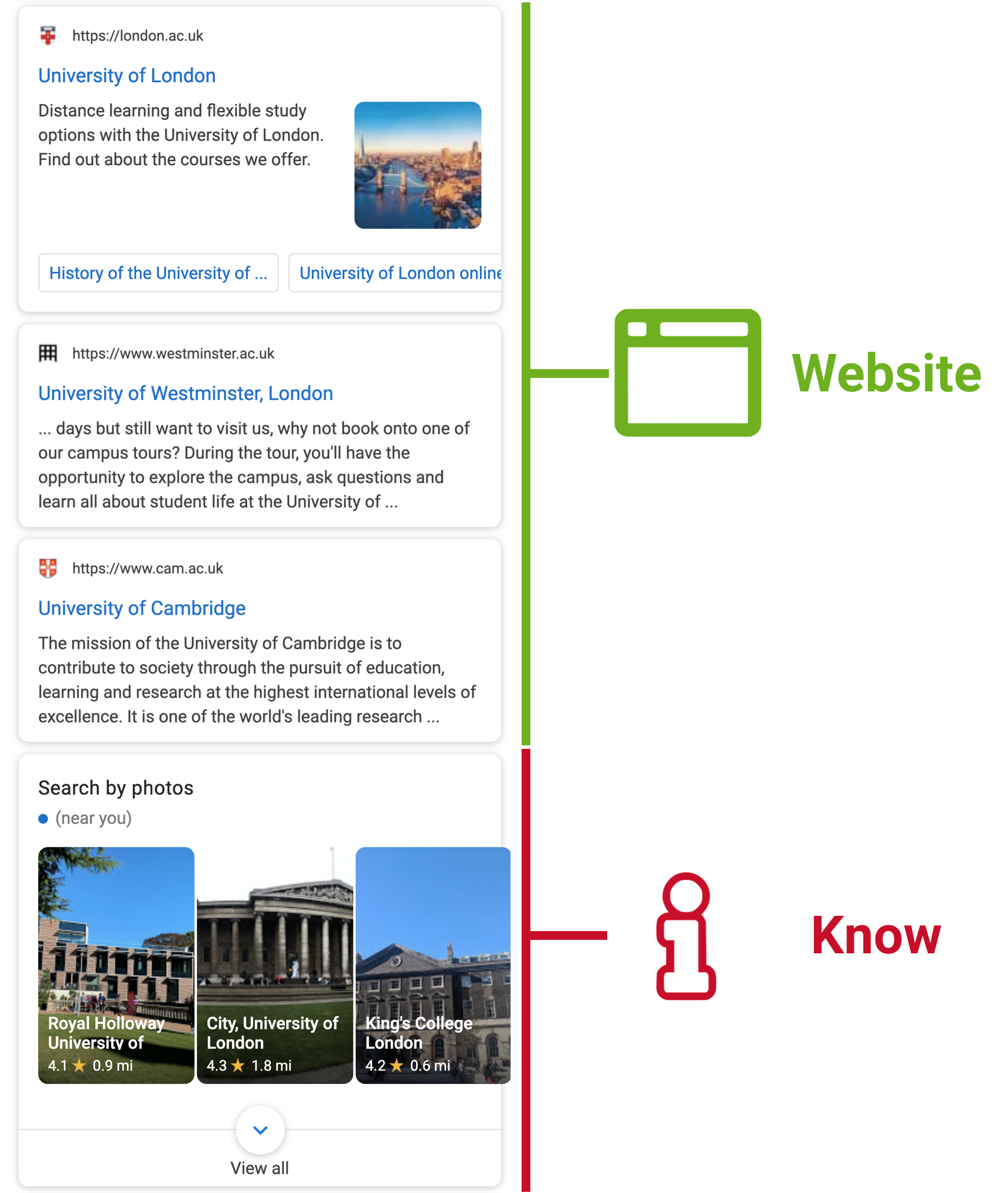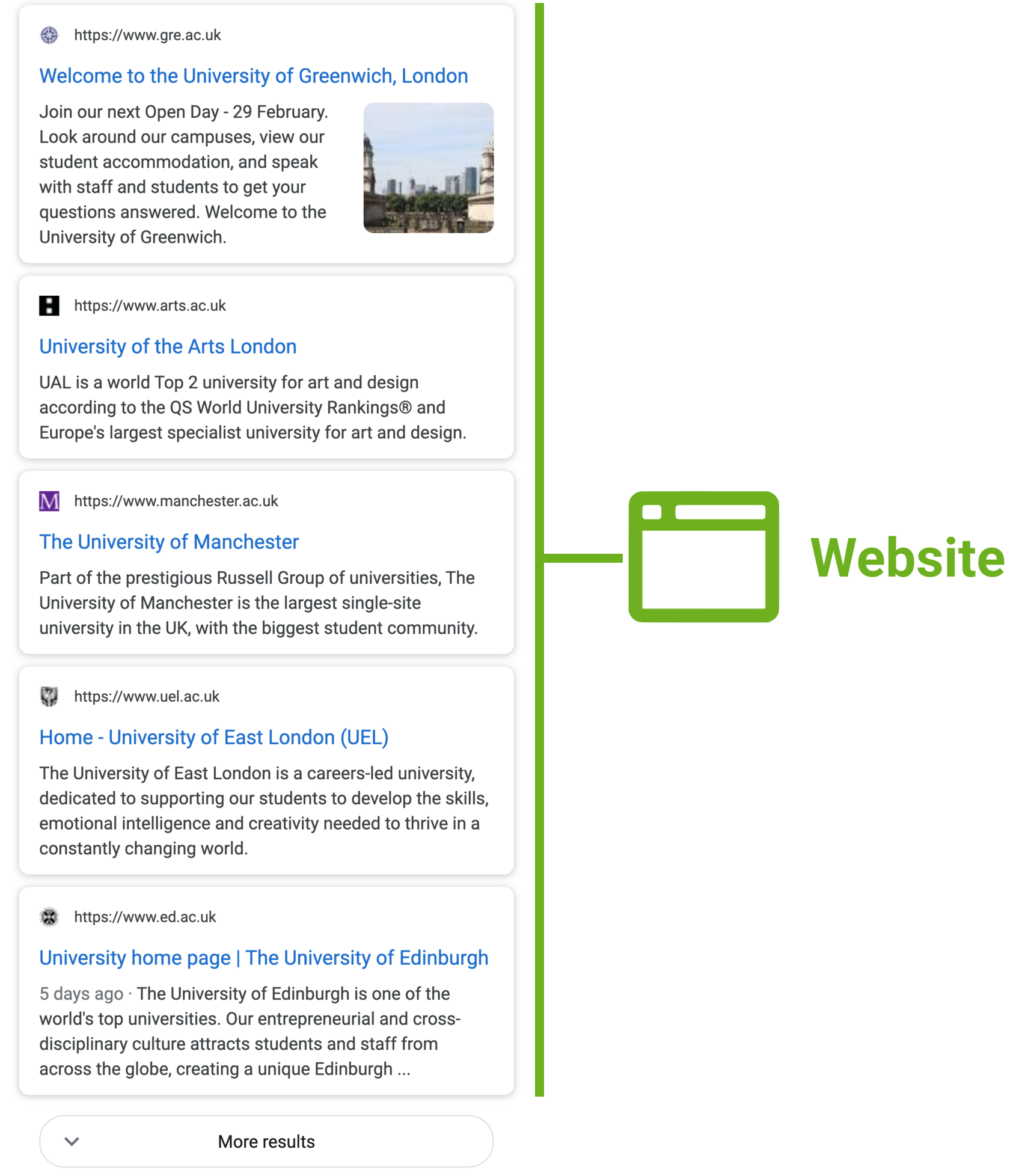The user intent, which is also refered to as search intent, is a concept in which Google categorises various search types: does the user want to know something (Know)? Does the user want to perform some action (Do)? Would they like to visit a specific website (Website) or rather a real-world location (Visit-in-person)? Maybe there is more than one intent behind one keyword (Multi-Intent)? Find out what they mean and how you can profit from this knowledge.
How is the user intent defined?
When we ask the question, “What purpose does the searcher have with their query?“, we find two sources that may hold an answer:
The first one is a study, that gets repeated numerous times in the SEO-industry. The paper “Determining the informational, navigational, and transactional intent of Web queries” from researchers at Penn State University use the definition of search intent from Rose and Levinson (2004) – who, in turn, invoke the work of Broder (2002). Their search intent is clustered into three categories: Informational (I would like to know something), Transactional (I would like to do something) and Navigational (I would like to go somewhere).
The second source is Google itself. In their Search Quality Evaluator Guidelines they have the section 12.7. “Understanding User Intent”, where they divide user intent into 4 categories.
Know queries
A user with a know query would like to “know more about something“. This intent is identical to the “informational search queries” from Broder, even though Google goes a step further.
In the Quality Rater Guidelines they added an extra sub-category for extremely specific answers. These “Know Simple” queries give “a very specific answer, like a fact, diagram, etc.” and are “correct and complete, and can be displayed in a relatively small amount of space the size of a mobile phone screen.“.
“Know Simple” is not used for queries that are neither unambiguous nor have one clear answer, queries that are too complex to be answered in short or queires where different users may want to see different types of information or information from different sources. Topics that are highly controversial are also exempt.
Do queries
Google’s definition of a do query is a user’s wish “to accomplish a goal or engage in an activity on a phone“.
This goal, or activity, does not necessarily have to have a transactional character, as is the case with Broder’s “transactional search queries”. A do query can also be the wish to download an app, as well as start a call, open a website or run an app on the phone. All interactions with websites or apps are also do queries, including such business transactions as a purchase.
The do queries also have their own sub-category, the “device action“. This includes all actions in which the mobile phone is ordered to fulfill a users action. This includes special requests, such as telling the phone to use a cars hands-free-headset. These device actions have a very clear intent as well as a specific action-trigger. An example for this would be “OK Google, call Mom”.
Website queries
The website queries are search requests in which the user would like to go to a specific website or page on that website. This intent covers the “navigational search queries” very well, as an action is always done in combination with a specific site.
A website search can be something as simple as a query for “Facebook”, but also this search for “red dancing shoes size 8 zappos” is a prime example for this intent. The person searching would like their question to be answered from one specific source.
Visit-in-Person queries
This user intent is Google’s way of addressing the fact that users are often using their mobile phone as the last step in their search journey. These searches include the question of where I can find the nearest ATM, a specific restaurant, a gas station and other extremely location sensitive queries.
Google does not care if the search query actually includes the wording “near me” (“where is the next gas station”) or if the question is explicitly adding my location (if I search for “pizza” I would most likely want to go eat somewhere close by). These are search queries where Google will heavily rely on their Google Maps integrations within the SERPs.
Google does admit that there are many good examples where a search cannot be clearly differentiated between someone looking to go to a website or whether they would raterh visit the brick-and-mortar store (Visit-in-Person). Examples for this are well known brands that have both an online as well as an offline presence. Examples are Tesco, Ikea as well as a search for “Apple store”.
These Visit-in-Person searches can also be strongly influenced by the local search behaviour. The example Google uses is a search for “Tumeric”, which will show anyone from Sunnyvale in California a different result than users from other locations around the world, because there is a Restaurant with that name in Sunnyvale, CA.
Google has the following advice in store, when you are wondering when a search query belongs to the search intent “Visit-in-Person“:
Use your common sense when thinking about queries and whether they have possible visit-in-person intent.
Multiple User Intent queries
There are numerous search queries which cannot easily be categorised into just one of these user intents. And they do not have to, because search results may contain a combination of different user intents.
This is often true for shorter, more general search queries. We will get into an example in a little bit, in our section on “Can you always clearly isolate a user intent?”.
Google asks their quality raters for the multiple user intent queries to use their own judgment in order to decide which search intent is the most likely intent for their target audience.
How important is the user intent for Google?
Google still makes the lion’s share of their money through advertisements. We showed that only about 7% of clicks actually go to ads. Most of the search queries that Google sees will be answered without even one Ad being shown and no monetarisation opportunity for Google. This comes along the limitation that Google will only show a maximum of 10 organic results per pages besides the up to 7 advertisements. This becomes a bottleneck.
For these non-commercial queries it is just as important for Google to return the (perceived) best results to users, in order for them to keep using Google as their search engine and not switching to a competitor.
Only when Google is able to recognize which intent is behind a search, are they able to return results that are most likely fitting for that user intent and therefore good results for the searchers.
If I am looking for the best places to visit during my trip to the USA – and am therefore expecting travel accounts and tips (a clear cut informational know intent) – but Google only shows me hotel platforms, then my search intent was not satisfied and I am frustrated.
If, on the other hand, I am looking for the newest Air Jordan sneakers (a transactional do query) and Google only shows reviews on the first result page than my search intent was also not addressed.
Why should I bother with the user intent?
As it is often the case in life, it is very hard or even impossible to make everyone happy with an article, or any other kind of content for that matter. This is the reason why it makes sense to align my own offerings with the user intent of those who I want to interact with my content.
If I believe that my visitors want to find the nicest travel accounts about the USA, then I should cater to exactly that intent and not try to sell them hotel bookings, come hell or high water.
In general, we can declare that informational queries will most likely be able to address a very broad audience, but mostly at the top of your marketing funnel. Transactional queries, on the other hand, are usually very far at the bottom of your funnel, as the visitor will usually already know what they want and just have to decide where to get the goods.
Navigational queries can be found from the middle to the end of your funnel as users already know from which website they want an answer. With this user intent it becomes important for you to turn those visitors into customers.
Based on the user intent you can also consider working with Google’s micro moments.
Can you always clearly isolate a user intent?
Sadly it is not possible to map each and every search query to just one specific user intent as either know, do, visit-in-person or website. Within the Penn State study, which we talked about at the beginning of this article and which was published in 2008, one of their core takeaways was that about 80% of searches were informational, 10% transactional and 10% navigational.
It has been more than 10 years since then and search engines have come a long way. Google especially has become a lot better in understanding user intent and how to measure it, so they can incorporate it into how they create their search result pages for a specific query.
There are a lot of search queries where we see a mix of different intents. Google defines them as “Multi-Intent” searches and we can see such a SERP with multiple intents in action if we search from London for “University“.



The results show that Google has learned, from their users, that they do not just want one type of answer. Some of those searing would like to take a closer look at the universities in the area. For them there are both a Google Maps entry – a Visit-in-Person intent – as well as the websites of numerous universities – a Website intent.
All the way at the top we find an advertisement, which is very good indicator that Google believes some users would actually like to do something after their search.
Then we have a Universal-Search image integration which is often used by searchers if they want to know more on a topic and there is a “People also ask” box. This box is made up of featured snippets and therefore caters to the “Know simple” intent.
Summing up the user intent
Only if I know what someone wants to achieve when they start a search can you offer them the best results for their needs. This makes is mandatory to understand the user intent of your visitors, because only by doing that can you come up with a strategy that creates the right content for the right audience.
We can count ourselves lucky that Google offers up a great window into what their users are intending to do. Just type in your keyword into the Google searchbar and take a look at the top 10 results. Which types of websites are in the results and what kind of content do they have to offer?